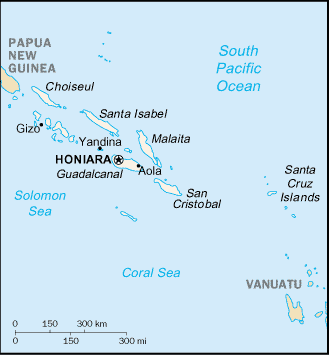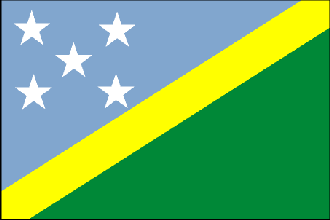
|
Solomon Islands
Background:
The UK established a protectorate over the Solomon Islands in the
1890s. Some of the bitterest fighting of World War II occurred on these
islands. Self-government was achieved in 1976 and independence two years later.
Current issues include government deficits, deforestation, and malaria control.
Location:
Oceania, group of islands in the South Pacific Ocean, about one-half of the way
from Hawaii to New Zealand.
Area: Total: 199 sq km, note: includes Rose Island and Swains Island.
Area - comparative: Slightly
larger than Washington, DC.
Coastline: 116 km.
Climate and Terrain:
Climate: Tropical monsoon; few extremes of temperature and weather.
Terrain: Mostly rugged mountains with some low coral atolls.
Elevation extremes: lowest point: Pacific Ocean 0 m highest point: Mount
Makarakomburu 2,447 m.
Natural resources: Fish, forests, gold, bauxite, phosphates, lead, zinc,
nickel.
Land use: Arable land: 1%, permanent crops: 1% permanent pastures: 1%
forests and woodland: 88% other: 9%.
Natural hazards: Typhoons, but they are rarely destructive; geologically active
region with frequent earth tremors; volcanic activity.
Environment - current issues: Deforestation; soil erosion; much of the
surrounding coral reefs are dead or dying.
People:
Population: 480,442.
Ethnic groups: Melanesian 93%, Polynesian 4%, Micronesian 1.5%, European 0.8%,
Chinese 0.3%, other 0.4%.
Religions: Anglican 34%, Roman Catholic 19%, Baptist 17%, United
(Methodist/Presbyterian) 11%, Seventh-Day Adventist 10%, other Protestant 5%,
indigenous beliefs 4%.
Languages: Melanesian pidgin in much of the country is lingua franca, English
spoken by 1%-2% of population note: 120 indigenous languages.
Government:
Government type: Parliamentary democracy
Capital: Honiara
Economy overview:
The bulk of the population depends on agriculture, fishing,
and forestry for at least part of their livelihood. Most manufactured goods and
petroleum products must be imported. The islands are rich in undeveloped
mineral resources such as lead, zinc, nickel, and gold. However, severe ethnic
violence, the closing of key business enterprises, and an empty government
treasury have led to a continuing economic downslide. Deliveries of crucial
fuel supplies (including those for electrical generation) by tankers have
become sporadic due to the government's inability to pay and attacks against
ships.
GDP - per capita: purchasing power parity - $2,000.
GDP - composition by sector: agriculture: 50% industry: 3.5% services:
46.5%.
Statistics:
Telephones - main lines in use: 8,000.
Telephones - mobile cellular: 658.
Radio broadcast stations: AM 3, FM 0.
Radios: 57,000.
Television broadcast stations: 0.
Televisions: 3,000.
Internet users: 3,000.
Highways: total: 1,360 km, paved: 34 km. Airports: 31, with paved runways: 2.
Return to Visiting Locations
|

